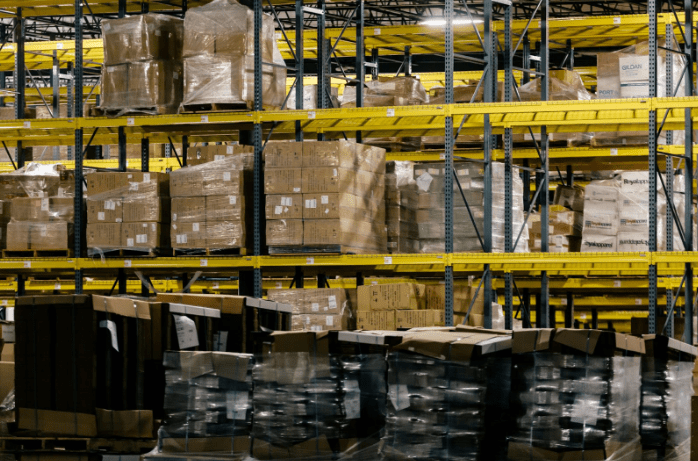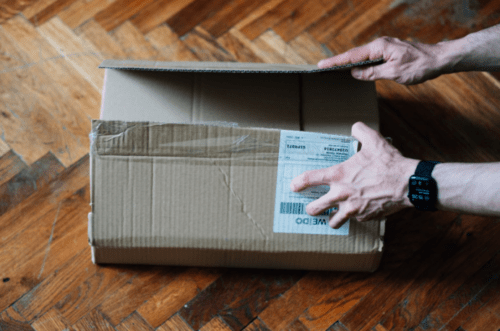Intermodal vs. Transloading: Definitions and Process

Intermodal and transloading are two methods of shipping products. They are similar, but understanding the difference between intermodal vs. transloading can help you choose the shipping method that works best for you logistically and financially.
The key differences between transloading vs. intermodal transportation are the methods of moving products. Intermodal is self-contained, while transloading physically moves stock items between transload facilities. Both use two or more transportation modes (trains, trucks, shipping from an intermodal or transload facility to the customer) to move products from point to point.
Each has its advantages and disadvantages.
Here’s a look at what each shipping method does and the pros and cons of each.
What Is Intermodal Shipping?
Intermodal shipping means moving a product from one point to another while keeping the product in a single container. The transport in the original container might utilize several different transportation modes, but the same container holds the stock throughout.
The most common path for an intermodal shipment is:
- A truck brings an empty container to a shipper.
- The container is loaded with cargo and moves by truck to the railyard.
- The container then moves onto a train, which takes it to the destination region.
- The container is then put on a truck, delivered to the receiver, and unloaded.
- The container is ready to be reused for another load.
Transporting intermodal cargo requires, at a minimum, an initial loading center that has multi-transportation options. Those include:
- An intermodal ramp to allow truck drivers to position trucks to onboard containers
- Access to railroad tracks for direct loading
- Access to docks to allow for loading of cargo onto ships
What Is Transloading Shipping?
With transloading shipping, freight is loaded and unloaded depending on where the cargo is in the supply chain process and the mode of transportation. At each supply chain transfer point, freight moves via containment modules.

When shippers, rail carriers, or truckers approach a transload facility, cargo gets offloaded from one container into a different container. At either end, freight gets stored in a specific container, such as:
- Rail car
- Flat car
- Tank car
- Box car
- Container ship
- Semi-truck
- Plane
The next step in the supply chain can, but does not have to, include:
- Storage in transloading facilities for holding or cross-docking
- Loading to flatbed trucks or semi-trucks for transport to the final destination
- Loading to some form of rail transportation (primarily shipments via trains)
- Holding the cargo for pickup by a customer
When shippers are responsible for point-to-point shipments, the final delivery to the customer is almost always done by some form of truck.
Intermodal vs. Transloading
The following are the logistics required for each form of transporting products.
Facilities
The facilities for both intermodal and transloading are the same, although a site dedicated to one form of transportation over the other might have site-specific equipment. At a minimum, both types of facilities are able to handle both loose shipping and intermodal shipping needs
For example, whether a site is an intermodal or transloading facility, it has the capacity to move both containers and cargo, depending on packaging. Some cargo, like steel beams or liquid, is best transported via transloading. Other products, like department store stock, can be best served by moving in the same container throughout.
Equipment Used
For intermodal shipping, the equipment used, at minimum, includes an intermodal ramp, cranes to lift containers, and a storage yard to hold the containers.
A transloading facility has the same equipment, but has more of a focus on facilitating the movement of individual products. Thus, a transloading system might include a conveyer belt, an electronic routing system, and loading ramps for trucks and trains.
Fees and Storage Costs
The fees associated with each type of transportation are essentially the same. The differences in cost depend on intangible characteristics. If one form of moving products were superior, everyone would use it. Different types of cargo, however, have different shipping needs and vulnerabilities.
That reality also affects storage costs. Intermodal requires a lot of container storage space. With transloading, you need to be able to store stock until you have a hauling method ready for loading.
Weight Limits
Weight limits depend on country regulations and, in the USA, state and local requirements.
Environmental Impact
The environmental impact of intermodal and transloading should be about the same, with few exceptions, because the same products get transported along the same processes. The only difference is that one requires loading and unloading stock at each step. There is likely more product loss with transloading, although shipping containers do get lost at sea.
In terms of carbon footprint, both are about the same.
How the Process Compares
Both intermodal vs. transloading systems have positive and negative aspects.
Intermodal Process
An intermodal process works like this:
- Products get packed into a shipping container
- The container is loaded onto the back of a truck and transferred to a rail car or ship
- Once secured, the product gets transported to another destination
- The container gets moved onto a truck for final delivery
The advantages of intermodal shipping are the following:
- Contained products mean there is less chance of loss in the shipping process
- There are fewer “moving parts,” which can speed up the delivery process
- Fewer forms of transport are needed
- The interchangeability of modes allows for greater flexibility
One disadvantage of intermodal shipping is that costs are higher if a shipping company or method is inefficient. One weak link in the process can cause costs to skyrocket.
The second disadvantage of intermodal shipping is that moving specific products becomes problematic if there is a shipping glut, which happened during the COVID-19 pandemic. A shipment of a product made overseas, for example, might be stuck in a container with other goods, so delivery will not happen until the entire container can be delivered.

Transloading Process
A typical journey for freight from an overseas supplier to a retailer, for example, would look like this:
- Supplier puts freight into a shipping container for a truck, plane, train, or ship
- Freight needing cross-sea delivery is put onto a ship or plane
- Upon reaching the destination, the freight gets put onto trucks
- The trucks take the freight to a rail loading area to await loading onto a train
- The freight gets moved into train rail cars
- When the train reaches a transfer point, the freight gets loaded onto trucks
- Trucks then deliver the freight to the retailer
With transloading, freight gets put into containers at a central loading point. Moving freight gets replicated at each phase of the shipment’s journey. The loading points have all the equipment needed (forklifts, trucks, storage, etc.) and are centrally located to allow for strategic freight transfer. Trucks are the most common form of transloading.
The advantages of transloading are that the entire system is flexible, so two or more modes of transport can be used, depending on cost. Being able to load and unload freight onto the vehicle of your choice creates the ability to save money by choosing the most efficient and cost-effective method.
Central loading facilities can also be positioned in locations that are convenient for the retailer. For example, if a container ship gets stuck in a port, transloading can take products off the ship in the port and onto individual shipping modules. A distribution center positioned near highways or rail can maximize hauling efficiency.
The drawback to transloading is that there is an increased risk of product loss. Loss can happen because of theft or damage in transit. There is also an elevated need to insure transloaded products because they are more vulnerable to risk.
Frequently Asked Questions
The following are commonly asked questions about intermodal and transloading systems.
Is transloading the same as cross-docking?
No, although it can be used in a cross-docking process. Transloading refers to transporting goods where cargo is loaded and unloaded at each step.
What are deconsolidation and reconsolidation?
Both are methods of handling products in shipping. Deconsolidation is taking one shipment and breaking it up, usually per the required mode of delivery. Reconsolidation is taking many products and merging them into one shipping method.
How is transloading different from international shipping?
Depending on the facility, transloading can be used in international shipping. Transloading, however, often leaves one facility to travel to another, whereas international shipping can do that but is often self-contained.
Conclusion
The intermodal vs. transloading services comparison comes down to shipping preference. With intermodal shipping, your products are in a container from start to finish. With transloading, your products are loaded and unloaded several times before you receive them.
Understanding how intermodal transportation and transloading systems work can help you make an informed decision to ensure your products get to you or your customers safely.
